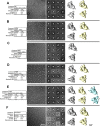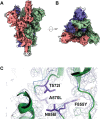This is a preprint.
Controlling the SARS-CoV-2 Spike Glycoprotein Conformation
- PMID: 32511343
- PMCID: PMC7252579
- DOI: 10.1101/2020.05.18.102087
Controlling the SARS-CoV-2 Spike Glycoprotein Conformation
Update in
-
Controlling the SARS-CoV-2 spike glycoprotein conformation.Nat Struct Mol Biol. 2020 Oct;27(10):925-933. doi: 10.1038/s41594-020-0479-4. Epub 2020 Jul 22. Nat Struct Mol Biol. 2020. PMID: 32699321 Free PMC article.
Abstract
The coronavirus (CoV) viral host cell fusion spike (S) protein is the primary immunogenic target for virus neutralization and the current focus of many vaccine design efforts. The highly flexible S-protein, with its mobile domains, presents a moving target to the immune system. Here, to better understand S-protein mobility, we implemented a structure-based vector analysis of available β-CoV S-protein structures. We found that despite overall similarity in domain organization, different β-CoV strains display distinct S-protein configurations. Based on this analysis, we developed two soluble ectodomain constructs in which the highly immunogenic and mobile receptor binding domain (RBD) is locked in either the all-RBDs 'down' position or is induced to display a previously unobserved in SARS-CoV-2 2-RBDs 'up' configuration. These results demonstrate that the conformation of the S-protein can be controlled via rational design and provide a framework for the development of engineered coronavirus spike proteins for vaccine applications.
Figures







References
Publication types
Grants and funding
LinkOut - more resources
Full Text Sources
Other Literature Sources
Miscellaneous
